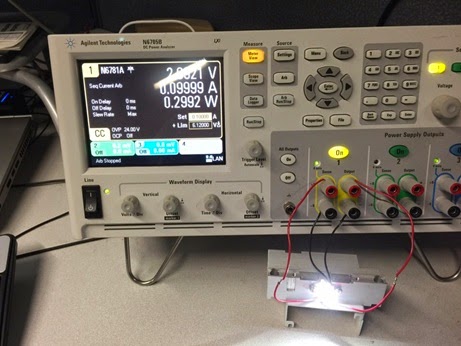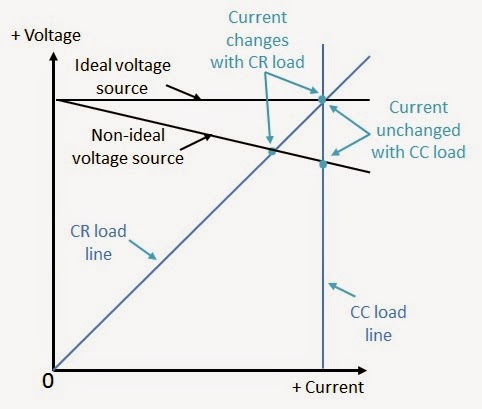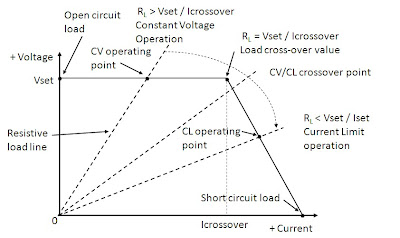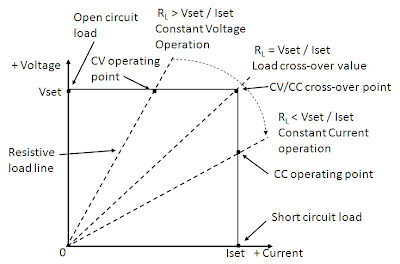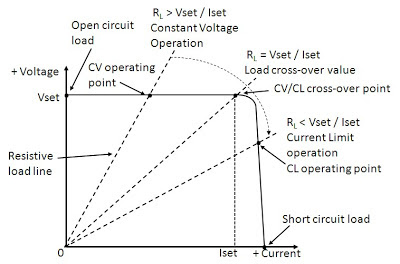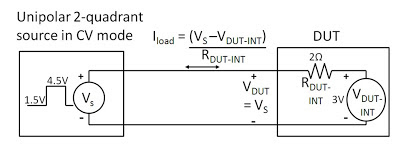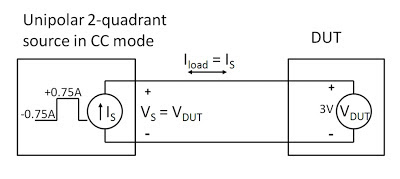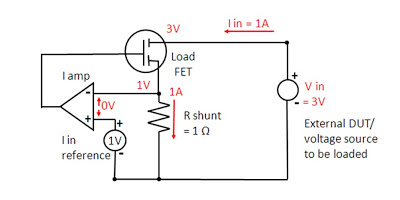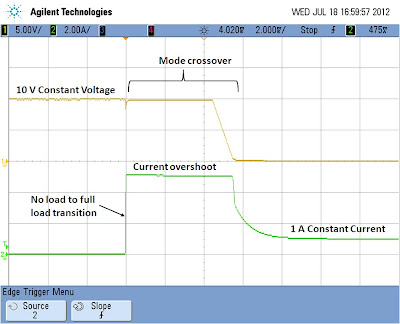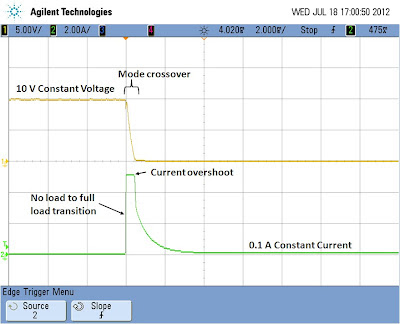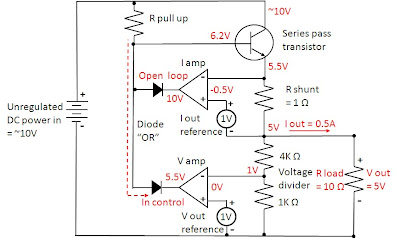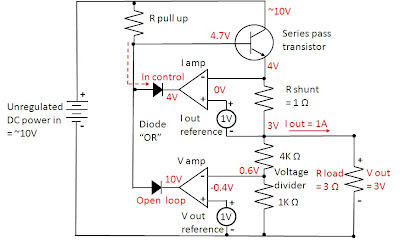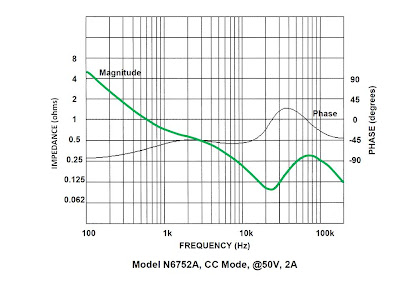Wednesday, March 11, 2015
Comparing effects of using pulsed and steady state power to illuminate a high brightness LED
Wednesday, August 20, 2014
Some differences between constant current (CC) and constant resistance (CR) loading on your DUT’s performance
Monday, February 24, 2014
How to test the efficiency of DC to DC converters, part 2 of 2

- In the 14585A the data logging mode was selected to make and display the measurements. The oscilloscope mode could have just as easily been used but with a 10 second sweep the extra speed of sampling with the oscilloscope mode was not an advantage. A second thing about using the data logging mode is you can set the integration time period for each acquisition point. This can be used to advantage in averaging out noise and disturbances as needed for a smoother and more representative result. In this case an integration period of 50 milliseconds was used.
- To synchronize the measurements the data log measurement was set to trigger off the start of the load current sweep.
- Voltage, current, and power for both the input and output SMUs were selected to be measured and displayed. The input and output power are needed for the efficiency calculation.
- The measurements were set to seamless ranging. In this way the appropriate measurement range for at any given point was used as the loading swept from zero to full load.
- A formula trace was created to calculate and display the efficiency in %. Note that the negative of the ratio of output power to input power was used. This is because the SMU acting as a load is sinking current and so both its current and power readings are negative.

Thursday, February 20, 2014
How to test the efficiency of DC to DC converters, part 1 of 2



Wednesday, November 6, 2013
Paralleling power supplies for more power without compromising performance!
Figure 2: Conditions of power supplies connected in parallel at light loading
Figure 3: N5700A Connection for parallel operation (local sensing used)
Friday, January 18, 2013
Types of current limits for over-current protection on DC power supplies
Tuesday, January 8, 2013
The difference between constant current and current limit in DC power supplies
- With no load (i.e. infinite load resistance): Iout = 0 and Vout = Vset
- With a load resistance of RL > Vset/Iset: Iout = Vset/RL and Vout = Vset
- With a load resistance of RL = Vset/Iset: Iout = Iset and Vout = Vset
- With a load resistance of RL < Vset/Iset: Iout = Iset and Vout = Iset*RL
- With a short circuit (i.e. zero load resistance): Iout = Iset and Vout = 0
Monday, December 10, 2012
More on power supply current source-to-sink crossover characteristics
Tuesday, August 7, 2012
How Does an Electronic Load Regulate It’s Input Voltage, Current, and Resistance?
Monday, July 23, 2012
Why Does My Power Supply Overshoot at Current Limit? Insights on Mode Crossover
Tuesday, July 17, 2012
How Does a Power Supply regulate It’s Output Voltage and Current?
Friday, April 27, 2012
Can a standard DC power supply be used as a current source?
Most DC power supplies can operate in constant voltage (CV) or constant current (CC) mode. CV mode means the power supply is regulating the output voltage and the output current is determined by the load connected across the output terminals. CC mode means the power supply is regulating the output current and the output voltage is determined by the load connected across the output terminals. When operating in CC mode, the power supply is acting like a current source. So any power supply that can operate in CC mode can be used as a current source (click here for more info about CV/CC operation).
Is a standard power supply a good current source?
An ideal current source would have infinite output impedance (an ideal voltage source would have zero output impedance). No power supply has infinite output impedance (or zero output impedance) regardless of the mode in which it is operating. In fact, most power supply designs are optimized for CV mode since most power supply applications require a constant voltage. The optimization includes putting an output capacitor across the output terminals of the power supply to help lower output voltage noise and also to lower the output impedance with frequency. So the effectiveness of a standard power supply as a current source will depend on your needs with frequency.
At DC, a power supply in CC mode does make a good current source. Typical CC load regulation specifications support this notion (click here for more info about load regulation). For example, an Agilent N6752A power supply (maximum ratings of 50 V, 10 A, 100 W) has a CC load regulation specification of 2 mA. This means that the output current will change by less than 2 mA for any load voltage change. So when operating in CC mode, a 50 V output load change will produce a current change of less than 2 mA. If we take the delta V over worst case delta I, we have 50 V / 2 mA = 25 kΩ. This means that the DC output impedance will always be 25 kΩ or more for this power supply. In fact, the current will likely change much less than 2 mA with a 50 V load change making the DC output impedance in CC mode much greater than 25 kΩ.
Of course, a power supply’s effectiveness as a current source should be judged by the output impedance beyond the DC impedance. See the figure below for a graph of the N6752A CC output impedance with frequency:
If the graph continued in the low frequency direction, the output impedance would continue to rise as a “good” current source should. At higher frequencies, the CC loop gain inside the product begins to fall. As the loop gain moves through unity and beyond, the output capacitor in the supply dominates the behavior of the output impedance, so at high frequencies, the output impedance is lower. So how good the power supply is as a current source depends on your needs with frequency. The higher the output impedance, the better the current source. The output impedance also correlates to the CC transient response (and to a much lesser extent, the output programming response time).
The bottom line here is that in most applications, a standard DC power supply can be used in CC mode as a current source.
Wednesday, March 28, 2012
What Is Going On When My Power Supply Displays “UNR”?
To gain better insight about CV, CC and UNR operating modes it is helpful to visualize what is going on with an IV graph of the power supply output in combination with the load line of the external device being powered. I wrote a two part post about voltage and current levels and limits which you may find useful to review. If you like you can access it from these links levels and limits part 1 and levels and limits part 2. This posting builds nicely on these earlier postings. A conventional single quadrant power supply IV graph with resistive load line is depicted in Figure 1. As the load resistance varies from infinity to zero the power supply’s output goes through the full range of CV mode through CC mode operation. With a passive load like a resistor you are unlikely to encounter UNREG mode, unless perhaps something goes wrong in the power supply itself.
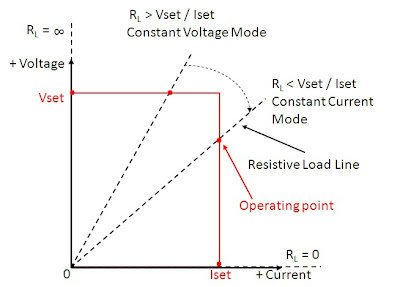 Figure 1: Single quadrant power supply IV characteristic with a resistive load
Figure 1: Single quadrant power supply IV characteristic with a resistive loadHowever, with active load devices you have a pretty high chance of encountering UNR mode operation, depending where the actual voltage and current values end up at in comparison to the power supply’s voltage and current settings. One common application where UNR can be easily encountered is charging a battery (our external active load device) with a power supply. Two different scenarios are depicted in Figure 2. For scenario 1, when the battery voltage is less than the power supply’s output, the point where the power supply’s IV characteristic curve and the battery’s load line (a CV characteristic) intersect, the power supply is in CC mode, happily supplying a regulated charge current into the battery. However, for scenario 2 the battery’s voltage is greater than the power supply’s CV setting (for example, you have your automobile battery charger set to 6 volts when you connect it to a 12 volt battery). Providing the power supply is not able to sink current the battery forces the power supply’s output voltage up along the graph’s voltage axis to the battery’s voltage level. Operating along this whole range of voltage greater than the power supply’s output voltage setting puts the power supply into its UNR mode of operation.
 Figure 2: Single quadrant power supply IV characteristic with a battery load
Figure 2: Single quadrant power supply IV characteristic with a battery loadA danger here is more sophisticated power supplies usually incorporate Over Voltage Protection (OVP). One kind of OVP is a crowbar which is an SCR designed to short the output to quickly bring down the output voltage to protect the (possibly expensive) device being powered. When connected to a battery if an OVP crowbar is tripped, damage to the power supply or battery could occur due to batteries being able to deliver a fairly unlimited level of current. It is worth knowing what kind of OVP there is in a power supply before attempting to charge a battery with it. Better yet is to use a power supply or charger specifically designed to properly monitor and charge a given type of battery. The designers take these things into consideration so you don’t have to!
I have digressed here a little on yet another mode, OVP, but it’s all worth knowing when working with power supplies! Can you think of other scenarios that might drive a power supply into UNR? (Hint: How about the other end of the power supply IV characteristic, where it meets the horizontal current axis?)
Wednesday, February 29, 2012
On DC Source Voltage and Current Levels and (Compliance) Limits Part 2: When levels and limits are not the same
I have been doing quite a bit of work with source measure units (SMUs) that support multi quadrant output operation. They in fact feature (constant) voltage sourcing and current sourcing modes of operation. This tailors the operation of the SMU for operating as a voltage source with a set current compliance range or conversely as a current source with a set voltage compliance range. Right at the start one difference is the set up conditions. The output voltage or current level is set to zero while the corresponding current or voltage limit is set to some value, often maximum, so that the DC source accordingly starts out in either constant voltage or constant current for normal operating conditions.
Some products feature a programmable or fixed power limits. In one product I know of, the programmable power limit acts accordingly to override and cut back the either the voltage limit when set for current sourcing, or the current limit when set for voltage sourcing. It does not do this in true real-time however. It cuts back the limit based on the level setting, as a convenient means as to help prevent the user from accidently over-powering the DUT. Alternately many auto-ranging output DC power sources exist that provide an extended range of output and voltage for a given output power capacity. They incorporate a fixed power limit to protect the power supply itself from being inadvertently overloaded, as shown in Figure 1. Usually the idea is for the user to stay below the limit, not operate in power limit. The point here on these examples is that the power parameter is an example of being a limit but not really a level.
 Figure 1: Auto-ranging DC power supply power limit
Figure 1: Auto-ranging DC power supply power limitMore to the point is some SMUs may incorporate two limits to provide a bounded compliance range with specified positive and negative limits. Not all DUTs are passive, non-reactive devices. As one illustrative example a DUT may be the output of 2-quadrant DC voltage source which you want to force up or down, within limits, or a battery you want to charge and discharge at a fixed rate, with your test system DC source. This set up is illustrated in Figure 2.
 Figure 2: Test system DC source driving the output of a DUT source
Figure 2: Test system DC source driving the output of a DUT sourceFigure 3 shows the constant voltage or voltage priority output characteristic for one particular SMU having two programmable current limits. Clearly both limits cannot also be the current level setting as you can only have one level setting. For the case of the external voltage source load line #1 (not all load lines are resistances!), when SMU voltage is less than the DUT source voltage (VEXT1 load line), the current is –ILIM. Conversely when SMU voltage is greater than the DUT source voltage (VEXT2 load line), the current is then +ILIM. In the case of the battery as a DUT this can be used to charge and discharge the battery to specified voltage levels. This desired behavior is achieved using voltage priority operation. Current priority operation would yield very different results. Understanding the nuances of voltage priority, current priority, levels, and limits is useful for getting more utility from your DC sources for more unusual and challenging power test challenges.
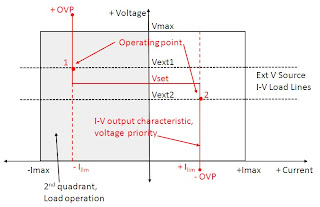 Figure 3: Example of a current priority output characteristic driving a DUT voltage source
Figure 3: Example of a current priority output characteristic driving a DUT voltage sourceIn closing I’ll concur with my colleague, in many test situations using most DC sources the voltage and current levels and limits may not have a meaningful difference. However, in many more complex cases, especially when dealing with active DUTs and using more capable DC sources and SMUs, there is a clear need for voltage and current level and limit controls that are clearly differentiated and not one and the same! What do you believe?
Wednesday, February 22, 2012
On DC Source Voltage and Current Levels and (Compliance) Limits Part 1: When levels and limits are one and the same
He based his argument on the case of a DC power supply that has both constant voltage and constant current operation. I’ll agree that is a reasonable starting point. As a side note there is a general consensus here that if it isn’t a true, well regulated constant voltage or constant current, whether settable or fixed, then it is simply a limit, not a level setting, end of story. He continued “if the load on the power supply is such that it is operating in constant voltage, then the voltage setting is the level setting and the current setting is the limit setting. If the load increases such that the power supply changes over from constant voltage operation into constant current operation then the voltage setting is becomes the limit setting and the current setting becomes the level setting!” (See figure 1.) He certainly has a good point! For your more basic DC power supply that only operates in quadrant 1 capable of sourcing power only, the current and voltage settings usually interchangeably serve as both the level and compliance limit setting, depending on whether the DC power supply is operating in constant voltage or constant current. The level and compliance limit regulating circuits are one and the same. Likewise with the programming, there are only commands to set the voltage and current levels. There are not separate commands for the limits. I might be starting to lose grounds on this discussion!
 Figure 1: Unipolar single quadrant DC source operation
Figure 1: Unipolar single quadrant DC source operationHowever, all is not lost yet. The DC power supply world is often more complicated than just this unipolar single quadrant operation just presented. Watch for my second part on when the levels and limits are not necessarily one and the same.
Tuesday, July 26, 2011
"Where's the CC button?"
There are two primary output operating modes for most power supplies: constant voltage (CV) mode and constant current (CC) mode. While you don't set the mode, you do set the output voltage setting and the output current setting. Then, the output operating mode is determined by what you connect to the output (the load).
The output operating mode is detemined by three things:
- Output voltage setting (Vset)
- Output current setting (Iset)
- Load value (Rload)
If the load current is low enough such that the current that is drawn is LESS than the current setting, the power supply will operate in CV mode regulating the voltage at a constant value with the current determined by the load.
If the load current is high enough such that the load is trying to draw MORE current than the current setting, the power supply will limit the current at the current setting value and operate in CC mode regulating the current with the voltage determined by the load.
Consider a simple resistive load, Rload:
If Rload > Vset / Iset, the power supply will be operating in CV mode.
If Rload < Vset / Iset, the power supply will be operating in CC mode.

The two extreme examples of the above are with Rload open (near infinite ohms) and Rload shorted (near zero ohms). When a power supply output is open (Rload = infinite, a vertical line from the origin on the graph), it should be obvious that the output will be in CV mode with no current flowing. When a power supply output is shorted (Rload = zero, a horizontal line from the origin on the graph), it should be obvious that the output will be in CC mode with near zero voltage.
Note that Agilent power supplies typically show the dynamic operating mode on the front panel. If the power supply is unable to regulate either the voltage or the current, the indicator will show UNR (unregulated) since neither the voltage nor the current is being regulated. This condition is rare, but can happen sometimes if Rload = Vset/Iset, or if there is a problem with the internal circuitry.
